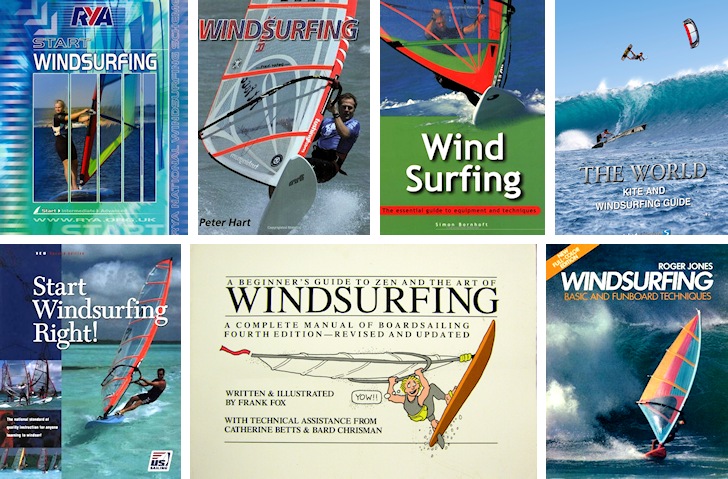The first windsurfing books hit the shelves in the 1980s when the sport's popularity exploded in Europe and the rest of the world.
Learning how to rig a sail, fine-tuning the art of luffing, uphauling, tacking and jibing, controlling speed, managing the water start, and harnessing.
From the basics of windsurfing to advanced sailing techniques, these windsurf books explored it all.
Looking back at these early windsurfing publications is understanding how the water sport has evolved through time.
More than 75 percent of these sailing books were published between 1980 and 1999.
The pace of publishing innovative, helpful windsurf books has decreased, but there are still fascinating guides coming out.
Modern windsurfing pays attention to details.
The sail settings and adjustments, the critical role of fins, the slight differences in windsurf board shapes, the customized preferences of the windsurfer, the GPS and surf cameras, and the advanced sailing techniques are all in constant change and need updated knowledge.
"The World Kite and Windsurfing Guide" introduces 100 regions and over 1,250 of the world's best spots. It comes with 700 photos and detailed maps, with an in-depth analysis of wind, wave, and weather conditions throughout the year.
"Windsurfing" (2001, Simon Bornhoft) is a must-have sailing book. Although it was designed to allow beginners to get on the board without delay, the book features interesting techniques and tips for intermediate windsurfers.
"Start Windsurfing Right!" (2002, James Coutts) was prepared and written by the US Sailing, the national governing body for wind sports in the USA. It covers all the skills you need to get started: gear, safety, rigging and equipment, wind, weather and currents, and rules of the road.
"Windsurfing" (2005, Peter Hart) is another perfect example of an instructional title, with stunning photographs and a full explanation of windsurfing equipment for the beginner and the expert. Improve your planing techniques and get along with smaller windsurf boards.
"RYA Start Windsurfing" (2008, Jim Collis) is designed by the Royal Yachting Association and delivers a unique windsurfing course for beginners. Chapters include wind awareness, static turning, steering and tacking, stance, upwind and downwind sailing, and jibing.
"RYA Intermediate Windsurfing" (2008, Simon Bornhoft) enters into more advanced levels. Learning how to sail in stronger winds, getting to grips with the harness and foot straps, and an introduction to more dynamic transitions are some of its multiple features.
"RYA Advanced Windsurfing" (2010, Simon Bornhoft) is the final book of the series aimed at taking people step by step through their windsurfing progression. Contents include carving gybes, water starts, and advanced planing techniques, all broken down and simplified by RYA's coaching formula.
"Freestyle Windsurfing" (1987, Roger Jones) is a vintage windsurfing book. A piece of history written when the Windsurfer was one of the most precious pieces of equipment in water sports. This rare guide will introduce you to easy freestyle tricks and extremely challenging maneuvers.
"Learn Windsurfing in a Weekend" (1997, Phil Jones) focuses on learning how to windsurf. It provides everything from basic information to the refined techniques necessary to participate at a competitive level, and it organizes each skill into manageable stages with clear goals.
"A Beginner's Guide to Zen and the Art of Windsurfing" (1988, Frank Fox) is a retro, classic, and humorous windsurf guide with lo-fi illustrations for book collectors and passionate windsurfers.
"Adventure Sports: Advanced Windsurfing" (1989, John Conway, Farrel O'Shea) aims at the intermediate and advanced windsurfing community. Learn transitions and tricks, and discover the lessons to learn in wave and speed sailing.
"Windsurfing" (1995, Ken Winner) has descriptions of some of the world's most popular windsurfing spots and even a glossary of windsurfing lingo to help you master the sport's unique terminology.
"Let's Go Windsurfing" (1994, Algis Steponaitis) comes with the stamp of the American Sailing Association and teaches the beginner how to master the basics and beyond. Get more than one hundred illustrations, diagrams, and photos with rig-handling techniques, wind theory, and gear.
"Windsurfing: Basics and Funboard Techniques" (1985, Roger B. Jones) offers an introduction to the techniques of windsurfing, high-performance tips, safety precautions, and the rules of the road.
